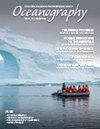Observations of Industrial Shallow-Water Prawn Trawling in Kenya
IF 2.8
4区 地球科学
Q1 OCEANOGRAPHY
引用次数: 0
Abstract
Ungwana Bay, located along the north coast of Kenya (Figures 1 and 2), began in the 1970s after exploratory fishing surveys identified the existence of fishable penaeid prawn stocks (Iversen, 1984). Small-scale fishers were also targeting the prawn resources in the bay. As trawlers fishing close to the shore destroyed nearshore habitats and the gear of small-scale fishers, resource-use conflicts arose between the trawler companies and small-scale fishers. To reduce these conflicts, in 1991, Kenya Fisheries Act Chapter 378 limited prawn trawling to beyond 5 NM from shore, with no industrial trawling allowed within a 0–3 NM zone. In 2010, a Prawn Fishery Management Plan recommended that trawling vessels carry a fisheries observer. However, it was not until this became a requirement in Article 147 of the 2016 Fisheries Management and Development Act that Kenya Fisheries Service (KeFS) observers began to work aboard trawlers; this article also expanded the observer program to cover all other commercial fishing operations such as longliners, purse seiners, and deepwater trawlers. The observer program provides data and information on fish catches and their composition, on the fate of target and non-target species, and on the fishing effort to enable evaluation of the status of the fishery and to inform reviews of the regulations in management plans. In this study, we analyzed the species composition of retained and discarded catches from 2016 to 2019 (using data collected by observers) and trawl catches between 2011 and 2019 (with fishing vessel log data provided by the trawl industry). The first KeFS-trained scientific observers were deployed in 2016 on four Kenyan-flagged industrial trawlers licensed to fish in the Malindi-Ungwana Bay during the prawn fishing season. They observed and recorded operations between April 1 and October 31 every year from 2016 to 2019 (Figure 1) aboard trawlers that were fitted with double rigged nets of 55–60 mm and 40–45 mm at the funnel and cod ends, respectively. Thirty-seven observer trips were executed for 168 days between 2016 and 2019 and recorded 1,371 out of 8,531 hauls. The catch composition data collected by肯尼亚浅水对虾工业拖网捕捞的观察
Ungwana湾位于肯尼亚北海岸(图1和图2),始于20世纪70年代,当时勘探性捕鱼调查发现存在可捕捞的对虾种群(Iversen,1984)。小规模渔民也瞄准了海湾中的对虾资源。由于靠近海岸捕鱼的拖网渔船破坏了近海栖息地和小规模渔民的渔具,拖网渔船公司和小规模捕鱼者之间出现了资源使用冲突。为了减少这些冲突,1991年,《肯尼亚渔业法》第378章将对虾拖网捕鱼限制在距离海岸5海里以上,在0-3海里的区域内不允许进行工业拖网捕鱼。2010年,《对虾渔业管理计划》建议拖网渔船配备一名渔业观察员。然而,直到这成为2016年《渔业管理和发展法》第147条的要求,肯尼亚渔业局(KeFS)的观察员才开始在拖网渔船上工作;本文还将观察员计划扩展到所有其他商业捕鱼作业,如延绳钓、围网渔船和深水拖网渔船。观察员方案提供有关鱼类捕捞量及其组成、目标物种和非目标物种命运以及捕捞努力的数据和信息,以便能够评估渔业状况,并为管理计划中的条例审查提供信息。在这项研究中,我们分析了2016年至2019年保留和丢弃渔获物的物种组成(使用观察员收集的数据)以及2011年至2019年间的拖网捕鱼量(使用拖网行业提供的渔船日志数据)。2016年,第一批经过KeFS培训的科学观察员被部署在四艘悬挂肯尼亚国旗的工业拖网渔船上,这些拖网渔船获准在对虾捕捞季节在Malindi Ungwana湾捕鱼。他们观察并记录了2016年至2019年每年4月1日至10月31日期间在拖网渔船上的作业(图1),这些拖网渔船在漏斗和鳕鱼端分别安装了55–60毫米和40–45毫米的双层网。2016年至2019年间,共进行了37次为期168天的观察旅行,记录了8531次旅行中的1371次。由
本文章由计算机程序翻译,如有差异,请以英文原文为准。
求助全文
约1分钟内获得全文
求助全文
来源期刊

Oceanography
地学-海洋学
CiteScore
6.10
自引率
3.60%
发文量
39
审稿时长
6-12 weeks
期刊介绍:
First published in July 1988, Oceanography is the official magazine of The Oceanography Society. It contains peer-reviewed articles that chronicle all aspects of ocean science and its applications. In addition, Oceanography solicits and publishes news and information, meeting reports, hands-on laboratory exercises, career profiles, book reviews, and shorter, editor-reviewed articles that address public policy and education and how they are affected by science and technology. We encourage submission of short papers to the Breaking Waves section that describe novel approaches to multidisciplinary problems in ocean science.
 求助内容:
求助内容: 应助结果提醒方式:
应助结果提醒方式:


